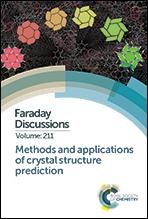Adventures in boron chemistry – the prediction of novel ultra-flexible boron oxide frameworks
Abstract
Recent periodic density functional calculations have predicted the existence of ultra-flexible low-energy forms of boron oxides in which rigid boron–oxygen heterocycles are linked by flexible B–O–B bridges. The minima in the energy landscapes of these frameworks are remarkably broad, with widths in excess of those of many hybrid metal–organic frameworks. Enormous changes in cell volume, which can exceed a factor of two, are accompanied by negligible changes in energy. Here we explore the underlying reasons for this behaviour using molecular electronic-structure calculations, periodic density functional theory and template-based geometric simulations. The angular flexibility of the B–O–B bridge depends only upon the geometry of the local B2O5 unit, independent of the configuration of neighbouring bridges. Unique cooperativity between the bending and twisting motions of the bridges leads to considerable anisotropy in framework flexibility. Exceptional flexibility is conferred not only by the intrinsic bending flexibility of the bridges but by topological factors, crucially the relaxation of torsional constraints when B3O3 rings are present. We test these conclusions by showing how the flexibility of the frameworks can be tuned by decoration with isoelectronic rings. The new nanoporous boron oxides presented in this work are predicted to be potential novel guest–host materials because of their flat energy landscapes. Furthermore, such structures can be generated systematically from silicates by the substitution of B2O54− for SiO44−. A borate analogue of β-cristobalite is shown to be isoenergetic with the known B2O3-I polymorph. We raise the possibility of new families of frameworks and zeolite analogues.

- This article is part of the themed collection: Methods and applications of crystal structure prediction


 Please wait while we load your content...
Please wait while we load your content...